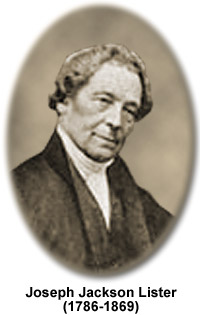Joseph Jackson Lister
(1786-1869)

Though microscopes and telescopes had been invented in the late sixteenth century, various optical difficulties meant that the devices were more commonly considered novelties than as useful scientific instruments for many years. Chief among these problems were aberrations in the images obtained that were caused by optical errors of the lenses they contained. Many scientists had attempted to rectify such difficulties, but the nineteenth century amateur microscopist Joseph Jackson Lister is credited with making some of the most important advances toward correcting image aberrations and establishing the microscope as a powerful means of carrying out serious scientific investigations.
Born in London, England on January 11, 1786, Lister was a Quaker whose interest in optics was sparked in his youth. He was reportedly a gifted student, but his formal education came to an end when he was only fourteen, at which time he began working with his father, a wine merchant. In 1804, he was granted a partnership in his fatherís business, which he would maintain throughout his life. He was also, however, engaged in other business ventures, such as acting as an investor in a ship that his brother-in-law would command. Furthermore, as a very influential Quaker, Lister was significantly occupied by religious activities as well as his scientific investigations. He met his wife, Elizabeth, who taught reading and writing, through his ongoing involvement with various schools. Together the couple had seven children, one of which, Joseph Lister, became a famous surgeon who was the first to develop antiseptic practices.
Joseph Jackson Lister began studying lenses in the mid-1820s, but his landmark paper explaining how lenses could be combined in a compound microscope in such a way that chromatic aberration was greatly reduced was not submitted to the Royal Society until 1830. Aided by the renowned optician William Tulley, Lister had found that by combining lenses of flint glass with those of crown glass and spacing them at specific distances from one another the refractive problems of one were amended by the other, enabling clearer microscopic observations than ever before. This information as well as the depiction of numerous experiments carried out by Lister impressed the Royal Society to such a great extent that they appointed him a fellow of the scientific academy. Also, soon after the revelation of Listerís discovery, his system was adopted widely by microscope makers, becoming an industry standard. Lister himself often advised London instrument makers and even began grinding his own lenses.
A notable consequence of the microscope improvements suggested by Lister was the elevation of histology into an independent science. Now that they were no longer plagued by optical error, microscopes revealed previously unseen details in tissues of all types, greatly advancing the medical knowledge base. In fact, Lister was the first to accurately observe and report the true appearance of red corpuscles present in mammalian blood. Other investigations carried out by the microscopist before his death on October 24, 1869 included those focusing upon zoophytes and the limits of the human vision system.
